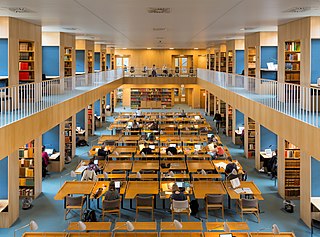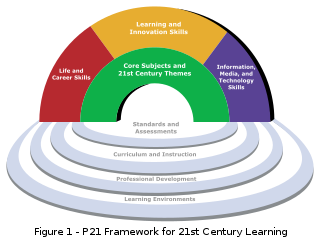
A library is a collection of books, and possibly other materials and media, that is accessible for use by its members and members of allied institutions. Libraries provide physical or digital materials, and may be a physical location, a virtual space, or both. A library's collection normally includes printed materials which may be borrowed, and usually also includes a reference section of publications which may only be utilized inside the premises. Resources such as commercial releases of films, television programmes, other video recordings, radio, music and audio recordings may be available in many formats. These include DVDs, Blu-rays, CDs, cassettes, or other applicable formats such as microform. They may also provide access to information, music or other content held on bibliographic databases.
Media literacy is an expanded conceptualization of literacy that includes the ability to access and analyze media messages as well as create, reflect and take action, using the power of information and communication to make a difference in the world. Media literacy is not restricted to one medium and is understood as a set of competencies that are essential for work, life, and citizenship. Media literacy education is the process used to advance media literacy competencies, and it is intended to promote awareness of media influence and create an active stance towards both consuming and creating media. Media literacy education is part of the curriculum in the United States and some European Union countries, and an interdisciplinary global community of media scholars and educators engages in knowledge and scholarly and professional journals and national membership associations.

A librarian is a person who works professionally in a library providing access to information, and sometimes social or technical programming, or instruction on information literacy to users.
The Association of College and Research Libraries defines information literacy as a "set of integrated abilities encompassing the reflective discovery of information, the understanding of how information is produced and valued and the use of information in creating new knowledge and participating ethically in communities of learning". In the United Kingdom, the Chartered Institute of Library and Information Professionals' definition also makes reference to knowing both "when" and "why" information is needed.

Visual literacy is the ability to interpret, negotiate, and make meaning from information presented in the form of an image, extending the meaning of literacy, which commonly signifies interpretation of a written or printed text. Visual literacy is based on the idea that pictures can be "read" and that meaning can be discovered through a process of reading.
Digital reference is a service by which a library reference service is conducted online, and the reference transaction is a computer-mediated communication. It is the remote, computer-mediated delivery of reference information provided by library professionals to users who cannot access or do not want face-to-face communication. Virtual reference service is most often an extension of a library's existing reference service program. The word "reference" in this context refers to the task of providing assistance to library users in finding information, answering questions, and otherwise fulfilling users’ information needs. Reference work often but not always involves using reference works, such as dictionaries, encyclopedias, etc. This form of reference work expands reference services from the physical reference desk to a "virtual" reference desk where the patron could be writing from home, work or a variety of other locations.
Library collection development is the process of systematically building the collection of a particular library to meet the information needs of the library users in a timely and economical manner using information resources locally held as well as resources from other organizations. "According to is a dynamic self perpetuation cycle or process and consists six definable stages namely,community analysis, selection policies, selection, acquisition, weeding and evaluation.
The Master of Library and Information Science (MLIS), also referred to as the Master of Library and Information Studies, is the master's degree that is required for most professional librarian positions in the United States. The MLIS is a relatively recent degree; an older and still common degree designation for librarians to acquire is the Master of Library Science (MLS), or Master of Science in Library Science (MSLS) degree. According to the American Library Association (ALA), "The master’s degree in library and information studies is frequently referred to as the MLS; however, ALA-accredited degrees have various names such as Master of Information Studies, Master of Arts, Master of Librarianship, Master of Library and Information Studies, or Master of Science. The degree name is determined by the program. The [ALA] Committee for Accreditation evaluates programs based on their adherence to the Standards for Accreditation of Master's Programs in Library and Information Studies, not based on the name of the degree."

The following outline is provided as an overview of and topical guide to library and information science:

A school library is a library within a school where students, staff, and often, parents of a public or private school have access to a variety of resources. The goal of the school library media center is to ensure that all members of the school community have equitable access "to books and reading, to information, and to information technology." A school library media center "uses all types of media... is automated, and utilizes the Internet [as well as books] for information gathering." School libraries are distinct from public libraries because they serve as "learner-oriented laboratories which support, extend, and individualize the school's curriculum... A school library serves as the center and coordinating agency for all material used in the school."
Library instruction, also called bibliographic instruction, user education and library orientation, consists of "instructional programs designed to teach library users how to locate the information they need quickly and effectively. [It] usually covers the library's system of organizing materials, the structure of the literature of the field, research methodologies appropriate to the academic discipline, and specific resources and finding tools " It prepares individuals to make immediate and lifelong use of information effectively by teaching the concepts and logic of information access and evaluation, and by fostering information independence and critical thinking. Above all they are aimed at equipping library users with skills to locate library sources and use them effectively to satisfy their information needs.

Sue Thomas is an English author. Writing since the late 1980s, she has used both fiction and nonfiction to explore the impact of computers and the internet on everyday life. In recent years her work has focused on the connections between life, nature and technology.

Information and media literacy (IML) enables people to show and make informed judgments as users of information and media, as well as to become skillful creators and producers of information and media messages. IML is a combination of information literacy and media literacy. The transformative nature of IML includes creative works and creating new knowledge; to publish and collaborate responsibly requires ethical, cultural and social understanding.
Data literacy is the ability to read, understand, create, and communicate data as information. Much like literacy as a general concept, data literacy focuses on the competencies involved in working with data. It is, however, not similar to the ability to read text since it requires certain skills involving reading and understanding data.
The Digital Visitor and Resident (V&R) model provides a framework to depict how user preference and habit motivates engagement with technology and the web. V&R is commonly described as a continuum, with two modes of online engagement at either end, making a separation between different approaches to engagement. People operating in Visitor mode have a defined goal or task, and select an appropriate online tool to meet their needs as they arise. For example, using a smartphone to search the internet for directions to a local bookstore, thus finding a particular piece of information online and then going offline to complete the task. There will be little in terms of social visibility or trace when online in Visitor mode. People operating in Resident mode are online to connect to, or to be with, other people. For example, posting to the wall in Facebook, tweeting, blogging, or posting comments on blogs. The web supports the projection of their identity and facilitates relationships. In other words, Residents live a percentage of their lives online. Unlike the Visitor mode, there will be online visibility and presence when in Resident mode. It is very common for individuals to engage online in a mixture of Visitor and Resident modes depending on what they are trying to achieve.

21st century skills comprise skills, abilities, and learning dispositions that have been identified as being required for success in 21st century society and workplaces by educators, business leaders, academics, and governmental agencies. This is part of a growing international movement focusing on the skills required for students to master in preparation for success in a rapidly changing, digital society. Many of these skills are also associated with deeper learning, which is based on mastering skills such as analytic reasoning, complex problem solving, and teamwork. These skills differ from traditional academic skills in that they are not primarily content knowledge-based.
Project Information Literacy (PIL) is a research institute that conducts national, ongoing scholarly studies on how early adults find and use information as they progress through, and beyond, their higher education years.
Metaliteracy is the ability to evaluate information for its bias, reliability, and credibility and apply them in the context of production and sharing of knowledge. It is especially useful in the context of the internet and social media. A formal concept of it was developed as an expanded information literacy framework by State University of New York academics Thomas P. Mackey and Trudi E. Jacobson. It has been used to prepare people to be informed consumers and responsible producers of information in a variety of social communities.
The CRAAP test is a test to check the objective reliability of information sources across academic disciplines. CRAAP is an acronym for Currency, Relevance, Authority, Accuracy, and Purpose. Due to a vast number of sources existing online, it can be difficult to tell whether these sources are trustworthy to use as tools for research. The CRAAP test aims to make it easier for educators and students to determine if their sources can be trusted. By employing the test while evaluating sources, a researcher can reduce the likelihood of using unreliable information. The CRAAP test, developed by Sarah Blakeslee and her team of librarians at California State University, Chico, is used mainly by higher education librarians at universities. It is one of various approaches to source criticism.

Helen Kay Raseroka is a librarian who was born in Kwazulu-Natal (Sudáfrica) with Botswana citizenship. She is a former President of The International Federation of Library Associations and Institutions (IFLA) from 2003 to 2005, under the theme "Libraries for lifelong literacy".









